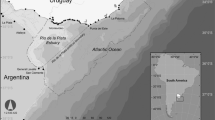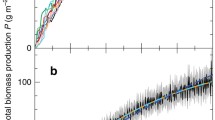Abstract
We developed a food web model of central Puget Sound to provide science-based support for ecosystem-based management and to refine our understanding of bottom-up and top-down trophic forcing. Phytoplankton accounted for a large fraction of total biomass, total throughput, and caused considerable bottom-up effects in most functional groups in a dynamic simulation fit to time series data from 1981 to 2000. Top-down control was most apparent in the case of bald eagles (Haliaeetus leucocephalus), which exhibited keystone tendencies and appeared capable of causing trophic cascades. Increasing top-down control in several predator–prey relationships improved model fits to time series data from 1981 to 2000, but not as much as introducing non-equilibrium dynamics (biomass accumulation terms) to several key vertebrates. Fishing had little effect on system dynamics. Our model appears well-suited for addressing strategic, scenario-based questions of how the community as a whole will respond to management actions.






Similar content being viewed by others
References
Ainsworth, C.H., T.J. Pitcher, J.J. Heymans, and M. Vasconcellos. 2008. Reconstructing historical marine ecosystems using food web models: Northern British Columbia from pre-European contact to present. Ecological Modelling 216: 354–368.
Aydin, K.Y., G.A. McFarlane, J.R. King, and B.A. Megrey. 2003. The BASS/MODEL report on trophic models of the subarctic Pacific basin ecosystems. PICES scientific report 25. Sidney: North Pacific Marine Science Organization (PICES).
Aydin, K.Y., G.A. McFarlane, J.R. King, B.A. Megrey, and K.W. Myers. 2005. Linking oceanic food webs to coastal production and growth rates of Pacific salmon (Oncorhynchus spp.), using models on three scales. Deep-Sea Research II 52: 757–780.
Baretta-Bekker, J.G., and J.W. Baretta (eds). 1997. Special issue: European regional seas ecosystem model II. Journal of Sea Research 38: 169–436.
Bower, J.J. 2009. Changes in marine bird abundance in the Salish Sea: 1975 to 2007. Marine Ornithology 37: 9–17.
BRT (Biological Review Team). 2009. Preliminary scientific conclusions of the review of the status of 5 species of rockfish: Bocaccio (Sebastes paucispinis), canary rockfish (Sebastes pinniger), yelloweye rockfish (Sebastes ruberrimus), greenstriped rockfish (Sebastes elongatus) and redstripe rockfish (Sebastes proriger) in Puget Sound, Washington. Seattle: Northwest Fisheries Science Center.
Christensen, V., and C.J. Walters. 2004. Ecopath with Ecosim: Methods, capabilities and limitations. Ecological Modelling 172: 109–139.
Christensen, V., C.J. Walters, and D. Pauly. 2005. Ecopath with Ecosim: A user’s guide. Vancouver: Fisheries Centre, University of British Columbia.
Darwall, W.R.T., E.H. Allison, G.F. Turner, and K. Irvine. 2010. Lake of flies, or lake of fish? A trophic model of Lake Malawi. Ecological Modelling 221: 713–727.
Essington, T.E. 2004. Getting the right answer from the wrong model: Evaluating the sensitivity of multispecies fisheries advice to uncertain species interactions. Bulletin of Marine Science 74: 563–581.
Essington, T.E. 2007. Evaluating the sensitivity of a trophic mass-balance model (Ecopath) to imprecise data inputs. Canadian Journal of Fisheries and Aquatic Sciences 64: 628–637.
Frank, K.T., B. Petrie, and N.L. Shackell. 2007. The ups and downs of trophic control in continental shelf ecosystems. Trends in Ecology & Evolution 22: 236–242.
Fresh, K.L. 2006. Juvenile Pacific salmon in Puget Sound. Puget Sound Nearshore Partnership report 2006–06. Seattle: US Army Corps of Engineers.
Fulton, E.A., A.D.M. Smith, and A.E. Punt. 2005. Which ecological indicators can robustly detect effects of fishing? ICES Journal of Marine Science 62: 540–551.
Goodwin, C.L., and B. Pease. 1989. Pacific geoduck clam. US Fish and Wildlife Service Biological Rep. 82(11.120). Vicksburg: US Army Corps of Engineers.
Gustafson R.G., W.H. Lenarz, B.B. McCain, C.C. Schmitt, W.S. Grant, T.L. Builder, and R.D. Methot. 2000. Status review of Pacific hake, Pacific cod, and walleye pollock from Puget Sound, Washington. NOAA Tech. Memo. NMFS-NWFSC-44.
Harvey, C.J., K.K. Bartz, J.R. Davies, T.B. Francis, T.P.Good, A.D. Guerry, M.B. Hanson, K.K. Holsman, J. Miller, M. Plummer, J.C.P. Reum, L.D. Rhodes, C.A. Rice, J.F. Samhouri, G.D. Williams, N.J. Yoder, P.S., Levin, and M.H. Ruckelshaus, 2010. A mass-balance model for evaluating food web structure and community-scale indicators in the central basin of Puget Sound. NOAA Tech. Memo. NMFS-NWFSC-106.
Hayward, J.L., J.G. Galusha, and S.M. Henson. 2010. Foraging-related activity of bald eagles at a Washington seabird colony and seal rookery. Journal of Raptor Research 44: 19–29.
Jeffries, S., H. Huber, J. Calambokidis, and J. Laake. 2003. Trends and status of harbor seals in Washington state: 1978–1999. Journal of Wildlife Management 67: 207–218.
Kaplan, I.C., and P.S. Levin. 2009. Ecosystem-based management of what? An emerging approach for balancing conflicting objectives in marine resource management. In The future of fisheries science in North America, ed. R.J. Beamish and B.J. Rothschild, 77–95. New York: Springer.
King County Water and Land Resources Division. 2009. Offshore monitoring water quality database. http://green.kingcounty.gov/marine/OffshoreMonitoring.aspx. Accessed 4 December 2009.
Knight, R.L., P.J. Randolph, G.T. Allen, L.S. Young, and R.J. Wigen. 1990. Diets of nesting bald eagles, Haliaeetus leucocephalus, in western Washington. Canadian Field-Naturalist 104: 545–551.
Libralato, S., V. Christensen, and D. Pauly. 2006. A method for identifying keystone species in model food webs. Ecological Modelling 195: 153–171.
McClure, M., and M. Ruckelshaus. 2007. Collaborative science: Moving ecosystem-based management forward in Puget Sound. Fisheries 32: 458–461.
Newsome, S.D., P.W. Collins, T.C. Rick, D.A. Guthrie, J.M. Erlandson, and M.L. Fogel. 2010. Pleistocene to historic shifts in bald eagle diets on the Channel Islands, California. Proceedings of the National Academy of Sciences (USA) 107: 9246–9251.
Palsson, W.A., T.J. Northup, and M.W. Baker. 1998. Puget Sound groundfish management plan (revised). Olympia: Washington Department of Fish and Wildlife.
Palsson, W.A., T. Tsou, G.G. Bargmann, R.M. Buckley, J.E. West, M.L. Mills, Y.W. Cheng, and R.E. Pacunski. 2009. The biology and assessment of rockfishes in Puget Sound. WDFW FPT 09-04. Olympia: Washington Department of Fish and Wildlife.
Parrish, J.K., M. Marvier, and R.T. Paine. 2001. Direct and indirect effects: Interactions between bald eagles and common murres. Ecological Applications 11: 1858–1869.
Partridge, V., K. Welch, S. Aasen, and M. Dutch. 2005. Temporal monitoring of Puget Sound sediments: Results of the Puget Sound Ambient Monitoring Program, 1989–2000. Pub. 05-03-016. Olympia: Washington Department of Ecology.
PFMC (Pacific Fishery Management Council). 2008. Review of 2007 ocean salmon fisheries. Portland: Pacific Fishery Management Council.
PSP (Puget Sound Partnership). 2008. Puget Sound action agenda: Protecting and restoring the Puget Sound ecosystem by 2020. Olympia: Puget Sound Partnership.
Ruckelshaus, M.H., and M. McClure (eds.). 2007. Sound science: Synthesizing ecological and socioeconomic information about the Puget Sound ecosystem. Seattle: Northwest Fisheries Science Center.
Schmitt, C., S. Quinnell, M. Rickey, and M. Stanley. 1991. Groundfish statistics from commercial fisheries in Puget Sound, 1970–1988. WDFW progress report No. 285. Olympia: Washington Department of Fish and Wildlife.
Stick, K.S. 2005. 2004 Washington state herring stock status report. Stock status Rep. 05-01. Olympia: Washington Department of Fish and Wildlife.
Stinson, D.W., J.W. Watson, and K.R. McAllister. 2007. Status report for the bald eagle. Olympia: Washington Department of Fish and Wildlife.
Strickland, R.M. 1983. The fertile fjord: Plankton in Puget Sound. Seattle: University of Washington Press.
Townsend, H.M., J.S. Link, K.E. Osgood, T. Gedamke, G.M. Watters, J.J. Polovina, P.S. Levin, N. Cyr, and K.Y. Aydin (eds). 2008. Report of the National Ecosystem Modeling Workshop (NEMoW). NOAA Tech. Memo. NMFS-F/SPO-87.
Wainger, L.A., and J.W. Boyd. 2009. Valuing ecosystem services. In Ecosystem-based management for the oceans, ed. K. McLeod and H. Leslie, 92–111. Washington, DC: Island.
Walters, C., V. Christensen, and D. Pauly. 1997. Structuring dynamic models of exploited ecosystems from trophic mass-balance assessments. Reviews in Fish Biology and Fisheries 7: 139–172.
Washington Department of Ecology. 2009. Puget Sound marine water quality database. http://www.ecy.wa.gov/apps/eap/marinewq/. Accessed 3 December 2009.
Williams, G.D., P.S. Levin, and W.A. Palsson. 2010. Rockfish in Puget Sound: An ecological history of exploitation. Marine Policy 34: 1010–1020.
Acknowledgments
We thank all who contributed to the NOAA technical memorandum (Harvey et al. 2010), upon which this work is based. Support, cooperation, and unpublished data were generously provided by scientists from the Washington Department of Fish and Wildlife (G. Bargmann, D. Bacon, G. Blatz, S. Burton, O. Eveningsong, J. Evenson, K. Henderson, L. Hoines, S. Jeffries, E. Kraig, M. Lance, G. Lippert, M. O’Toole, W. Palsson, S. Pearson, B. Sizemore, K. Stick, D. Stinson, and J. Watson), King County (S. Mickelson), the Puyallup Tribe of Indians (A. Berger), the Washington Department of Ecology (M. Dutch), the Northwest Indian Fisheries Commission (B. Patton), and the NOAA Northwest Fisheries Science Center (A. Albaugh, K. Bartz, A. Guerry, T. Good, and C. Rice). J. Davies created Fig. 1. E. Quimby and B. Tarrant assisted with table creation. I. Valiela, J. Samhouri, I. Kaplan, C. Ainsworth, and four anonymous reviewers provided valuable comments on earlier versions of this paper. This research was supported by funds from the U.S. Environmental Protection Agency.
Author information
Authors and Affiliations
Corresponding author
Electronic Supplementary Material
Below is the link to the electronic supplementary material.
Table A1
(PDF 70 kb)
Table A2
(PDF 218 kb)
Table A3
(PDF 30 kb)
Table A4
(PDF 34 kb)
Fig. A1
Annual landings of functional groups in the PSCB domain, for which time series data were available for most of the 1981–2000 time period. In the three cases where there were “no data” for extended time periods (spiny dogfish, Pacific cod, and small-mouthed flatfish), we assumed landings equal to the mean of all available data between 1981 and 2000. (PDF 35 kb)
Rights and permissions
About this article
Cite this article
Harvey, C.J., Williams, G.D. & Levin, P.S. Food Web Structure and Trophic Control in Central Puget Sound. Estuaries and Coasts 35, 821–838 (2012). https://doi.org/10.1007/s12237-012-9483-1
Received:
Revised:
Accepted:
Published:
Issue Date:
DOI: https://doi.org/10.1007/s12237-012-9483-1




